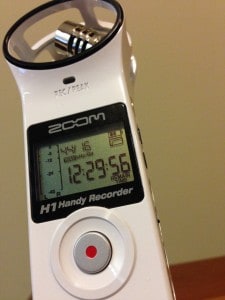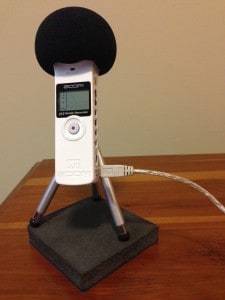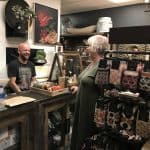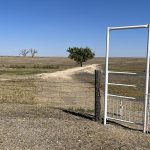
My podcasting toy: a Zoom H1 that works as a mic at my desk or as a sound recorder in the field. Photo by Becky McCray.
Your fellow reader Rhonda Howell asked for tips, tricks, and sound advice for podcasting. Since I’ve dabbled with podcasting on and off since 2006, I wanted to offer my opinion on some basics.
Step 1. Know what you want to say.
Have a purpose for your podcast. Write down the reason you’re creating a podcast. What do you hope to accomplish? What will change because you do this project? Here are some example purposes:
- To increase awareness of local businesses.
- To get people to take action to shape the future of their towns.
- To help businesses succeed with better marketing online.
Know what you want to cover in each interview or session. Will you have a consistent set of questions you’ll cover? Any structure of special features you’ll include each time?
Step 2. Record the audio.
Recording audio seems to really intimidate some people. Here are four easy ways to get the audio captured.
A. Use the sound recorder on your phone. This is an easy way to start with equipment you already have, and you can record anywhere you have your phone. You can use the built-in mic or a set of earphones with a compatible mic. (Most phones come with a free set.)
The easiest way is to use a dedicated podcasting app like Anchor that will automate much of the process.
If you don’t want to use Anchor, there are more options. From iPhone, you can use email to get shorter audio clips to your computer. Test this before recording important stuff. I’ve read that transferring files can be tricky. Or, use an app like AudioBoom or Evernote that will both record audio and transfer the file automatically to your synced computers.
B. Use a headset with a built-in mic on your computer. You might have one of these already for Skype or to use with games. They usually do an OK job with audio. You do have to be sitting at your computer to use one. I used this method for a long time, often getting better results than folks with more expensive equipment. Another option is that free set of earphones with a mic that came with your smartphone. Plug it in and try it.
C. Use a separate USB mic on your computer. This is a usually a step up in audio quality over the other methods. I have used a Zoom H1 because I can also use it in the field. (It’s both a USB mic and a portable audio recorder.) I also have and use a Blue Microphones Yeti model. (I caught an older model on sale when they introduced new colors!) It’s too bulky for field work, but is great on a desktop.
D. Use the mic built into your laptop. This is a low quality option. But if it’s all you’ve got right now, start here and experiment.
It’s better to start with your existing tools than to wait until you get something new. You’ll learn by doing.
It’s more important to have something interesting to say than to obsess over tools.
3. Edit the audio.
The most common option is to use Audacity on Windows or Mac. It’s reasonably easy to learn, and works well to cut off any extra space at the beginning or end, or to silence extraneous noises. It’s also extremely powerful, so you can continue to use it as you learn and grow. If you search online for Audacity tutorials for beginners, you’ll find a wealth of articles and videos to help you get started.
If you’re using an all-in-one app like Anchor, you can skip over this step.
4. Post the audio.
Short answer: it’s tricky. Basically you need to upload the audio files where the public can access them. If you already have web hosting, you can include your podcast files there. I purchased some very inexpensive web hosting to hold podcast files and other downloads. This works OK for me. To learn more, check this review of podcast hosting options at Technorms.
If you used the Anchor or AudioBoom apps I mentioned earlier, they will host your files for you. Just remember that the service can change the rules at any time. In fact, AudioBoom has made some changes that irritated many who podcasted with them. So I recommend you look into your own file hosting or at the very least always backup your audio files on your own computer.
5. Post the text description of your recording.
You’ll want to include a description of the episode and any links or resources you mentioned. If this is on a separate host, like AudioBoom or Anchor, they’ll let you create your description when you record the audio. If it’s on your own site, you want to include the audio enclosure in the RSS feed. If that sounded like gibberish, use a WordPress site and one of the many podcasting plugins to take care of the technical details of enclosures and RSS feeds. I use my existing WordPress website with the Seriously Simple Podcasting plugin because seriously simple sounded like exactly what I wanted.
6. Promote and distribute.
For your first few podcasts, you’ll be learning. You’ll make mistakes, and when you go back and listen later, you may be surprised how much you’ve improved. So when you are first learning, absolutely post them and share them, but you may not want to promote them to everyone on earth.
When you are ready to share with the world, start promoting it everywhere:
- Promote in your existing websites and email lists.
- Promote in your social channels.
- Add your podcast to iTunes. (Seriously Simple Podcasting plugin makes this fairly easy.)
- Apply to Stitcher Radio.
If you’re using an all-in-one app like Anchor, they will walk you through this step. You’ll only have to do the setup once.
Podcasting Tips:
1. Keep it short. It’s easier to go back and redo if you mess up. It’s easier to edit. It’s much easier for learning.
- 3 to 5 minutes is great starting length.
- 10 to 15 is also great after you gain some experience.
- 30 minutes is pretty long.
- An hour is too long, unless you have professional-level skills and can tell a truly gripping story.
2. Keep it interesting. What parts would listeners be excited to hear? What’s the most useful thing you could offer? Cut it down, and just do the interesting part.
3. Keep improving. Improve your audio. Improve your interviewing. Improve your planning.
Sound Tips:
1. Find your quiet place. Find the place in your house (or office) that has the fewest background noises. You’re used to hearing them, so you don’t even notice. So you have to stand still, pay attention and listen for them. My big wind-up clock makes a wonderfully nostalgic tick-tock that is loud enough to be picked up by my mic! So I have to go to a different room to record.

My improvised sound isolator: a piece of foam between the mic stand and the desk to keep stray vibrations from being picked up by the mic. Photo by Becky McCray.
2. Your mic wants to be alone. For freestanding mics, get them up off the desk and away from everything. I use a mini-tripod to lift mine off the desk. The mini-tripod sits on top of a sound isolator. (OK, so really it’s just a chunk of foam, but it does keep vibrations in the desk from being translated to the mic.) For a headset mic, don’t get the mic boom (or arm) right next to your mouth or nose. Better to slide it down towards your jawline where it won’t be affected by the breeze. Record tests to find the best-sounding position.
3. Pop filters and foams help. My standalone mic has a big foam cap. I use it even indoors because it seems to cut down on strange air noises. When I used a USB headset, it didn’t come with a foam cap for the mic, so I made one. I think it was an old shoe polish foam applicator that I cut down. Hey, don’t laugh. It worked really well!
4. Listen. Make a lot of test recordings just to work on sound issues. Record 10 seconds, then play it back and listen. What can you hear? Can you fix the issues? Make some changes and try again. Listen, listen, listen.
5. Do what it takes to get the story. I’ve had to drop all the high-tech tools and use a land-line conference call service because it was the only way I could connect with someone I really wanted to interview. My audience is mostly rural people, so I simple explained the rural technology challenge we had run into, and I shared the interview anyway. I think most folks understood.
My Podcast
You’ll find it at A Positive View of Rural Podcast.
Your Podcasting Tips
You’ve done some podcasting. You probably have figured out more than I have. What have you learned that you’d like to share?
Updated in 2018 with Anchor.fm app.
New to SmallBizSurvival.com? Take the Guided Tour. Like what you see? Get our updates.










